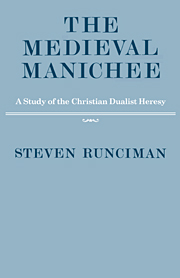Book contents
- Frontmatter
- Contents
- CHAPTER I Introduction
- CHAPTER II The Gnostic Background
- CHAPTER III The Paulicians
- CHAPTER IV The Bogomils
- CHAPTER V The Patarenes
- CHAPTER VI The Cathars
- CHAPTER VII The Dualist Tradition
- APPENDIX I The Greek Sources for Paulician history
- APPENDIX II Heretical Movements in the Eighth Century
- APPENDIX III Various Names given to the Dualist Heretics in Europe
- APPENDIX IV Dualism, Buddhism and Occultism
- BIBLIOGRAPHY
- ADDITIONS (1982)
- INDEX
CHAPTER II - The Gnostic Background
- Frontmatter
- Contents
- CHAPTER I Introduction
- CHAPTER II The Gnostic Background
- CHAPTER III The Paulicians
- CHAPTER IV The Bogomils
- CHAPTER V The Patarenes
- CHAPTER VI The Cathars
- CHAPTER VII The Dualist Tradition
- APPENDIX I The Greek Sources for Paulician history
- APPENDIX II Heretical Movements in the Eighth Century
- APPENDIX III Various Names given to the Dualist Heretics in Europe
- APPENDIX IV Dualism, Buddhism and Occultism
- BIBLIOGRAPHY
- ADDITIONS (1982)
- INDEX
Summary
THE Fathers of the Church, usually so careful and so precise, were now and then hesitant on matters of fundamental theology. Indeed, to one most essential question they long gave no clear answer. Concentrating their attention on the Redemption from sin, they ignored the problem of the original cause of sin. Yet sin was a very real thing to the Early Christians. The world that they knew, the cruel, luxurious, uncertain world of the Roman Empire, was undoubtedly a wicked place. How had such wickedness come into creation? If God was the Creator, and God was omnipotent and good, why did he permit such things to be? The Fall might explain why man was enchained in sin, but the Fall could not create sin; rather it was sin that created the Fall.
It is a desire to solve the problem of Evil that lies at the base of Gnosticism. The heretics and philosophers, complained Tertullian, were always asking the same question: “Whence came Evil, and in what does it exist?” and the question that arises out of it: “Whence and how came Man?” Unguided by the Church the heretics and philosophers sought out their own solutions and out of their searching Christian dualism was founded.
The origin of Gnosticism must remain obscure. Partly it is to be sought in the age-long magical tradition. Gnostic writings such as the Pistis Sophia seem to be connected with the Hermetic occultism of the Egyptians, and the Gnostic doctrine of the Eons resembles Kabalistic lore with its archangels.
- Type
- Chapter
- Information
- The Medieval ManicheeA Study of the Christian Dualist Heresy, pp. 5 - 25Publisher: Cambridge University PressPrint publication year: 1982



